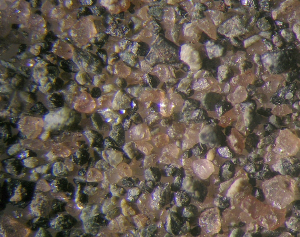Part 1: Observations and first hypothesis of formation
Kord Ernstson* (2018)
Abstract. – Pink quartz, not to be confused with rose quartz, is an extremely rare color variety, which is completely transparent and is only known from a few occurrences worldwide. It is believed that the pink color is due to small amounts of aluminum and phosphorus that substitute silicon, and exposure of the quartz to natural gamma radiation. Sands with a dominating proportion of pink quartz excavated from the soil and extracted from a breccia layer in the crater strewn field of the Chiemgau meteorite impact suggest that normally colorless quartz sand was irradiated during the impact event and may possibly be found at other impact sites.
Key words: Pink and rose quartz, Chiemgau meteorite impact, neutron-gamma radiation
____________________________________________
*Faculty of Philosophy I, University of Würzburg, Germany, email: kernstsoneternstson.de
1 Introduction
Colors from ionizing radiation is an effect that occurs in many minerals as a result of natural and artificial exposure. Well known colored quartz transparent crystal varieties are amethyst, citrine and smoky quartz.
Pink quartz crystals were first discovered in the 1930’s in Maine, USA, and later in 1959 in Minas Gerais in Brazil (Dake, et al. 1938, Akhavan 2005-2013). In both cases the pink quartz was considered as common rose quartz that formed crystals. Only recently pink quartz crystals have been found also in the Himalayan Mountains, and pink quartz in general goes round in esoteric circles as so-called “healing stones”.
This “crystalline rose quartz” raised the interest of mineralogists who found distinct differences between pink quartz and common rose quartz, which is now generally accepted (Balitsky et al. 1998, Hori 2001, Maschmeyer and Lehmann 1983, Rykart 1995). In their opinion the pink quartz forms in phosphorous-rich pegmatites where few silicon is replaced by phosphorous and aluminum, and the color is the result of gamma ray radiation from uranium, thorium and potassium-40 decay in the rock, which may affect existing trapped-hole centers. Exposure to sunlight (UV) and heating above 200°C leads to discoloration.
Here I report on the discovery of quartz sands composed of a dominating fraction of pink quartz grains that are suggested to be related with the meanwhile established Chiemgau meteorite impact in Bavaria, Southeast Germany.
2 The Chiemgau impact event
The Chiemgau impact strewn field (Schüssler et al. 2005; Rappenglück et al. 2009; Ernstson et al. 2010, 2012; B. Rappenglück et al. 2010; Liritzis et al. 2010; Hiltl et al. 2011) discovered in the early new millennium and dated to the Bronze Age/Celtic era comprises about 100 rimmed craters scattered in a region of about 60 km length and ca. 30 km width in the very South-East of Germany (Fig. 1). The crater diameters range between a few meters and a few hundred meters, among them Lake Tüttensee with a rim-to-rim diameter of about 600 m and an extensive ejecta blanket. SONAR echosounder measurements show a striking structure at the bottom of Lake Chiemsee, which is completely untypical for the bottom of an ice-age lake. The structure measuring about 800 m x 400 m is a doublet crater with a ring wall. Since the crater strewn field extends beyond Lake Chiemsee, it is plausible that fragments of the large meteorite have also fallen into Lake Chiemsee and created craters on the ground (Fig. 1). The height of the resulting tsunami could exceed several decameters. Clear indications of such a tsunami are provided by diamictites with pronounced block layers and cross bedding, as they can be found in various gravel pits on the eastern side of Lake Chiemsee (Ernstson 2016).
Geologically, the craters occur in Pleistocene moraine and fluvio-glacial sediments. The craters and surrounding areas are featuring heavy deformations of the Quaternary cobbles and boulders, abundant fused rock material such as impact melt rocks and various glasses, strong shock metamorphism (planar deformation features [PDFs] in quartz and feldspar, diaplectic glass from quartz and feldspar), geophysical (gravity, geomagnetic, ground penetrating radar) anomalies (Ernstson et al. 2010; Neumair and Ernstson 2011, Rappenglück et al. 2017) and widespread impact-induced rock liquefaction features (Ernstson et al. 2011, Ernstson and Neumair 2011, Ernstson and Poßekel 2017). Impact ejecta deposits in a catastrophic mixture contain polymictic breccias, shocked rocks, melt rocks, and artifacts from Neolithic and Bronze Age/Iron Age people The impact is substantiated by the abundant occurrence of metallic, glass and carbonaceous spherules, accrecionary lapilli and microtektites (Ernstson et al. 2012, 2014). Strange, probably meteoritic matter in the form of iron silicides like gupeiite, xifengite, hapkeite, naquite and linzhite, various carbides like, e.g., moissanite SiC and khamrabaevite (Ti,V,Fe)C, and calcium-aluminum-rich inclusions (CAI), minerals krotite and dicalcium dialuminate (Hiltl et al. 2011; Rappenglück et al. 2014) add to the finds. Carbonaceous spherules contain fullerene-like structures and nanodiamonds that point to an impact-related origin (Yang et al. 2008). Such spherules were found embedded in the fusion crust of cobbles from a crater as well as a possible outfall in soils widespread over Europe (Rösler et al. 2005; Hoffmann et al. 2006; Yang et al., 2008). Abundant finds of glass-like carbon fragments with pumice texture, which has been given the name chiemite, contain the carbon allotropes diamond and carbyne in a largely amorphous matrix of more than 90 % carbon (Shumilova et al. 2018). A formation of a direct airburst shock transformation of the target vegetation (wood, peat) to carbon melt and vapor in the impact event is suggested.
Physical and archeological dating confines the impact event to have happened most probably between 2,200 and 500 B.C. (Rappenglück et al. 2010; Liritzis et al. 2010). The impactor is suggested to have been a roughly 1,000 m sized low-density disintegrated, loosely bound asteroid or a disintegrated comet in order to account for the extensive strewn field (Ernstson et al. 2010, Rappenglück et al. 2017).
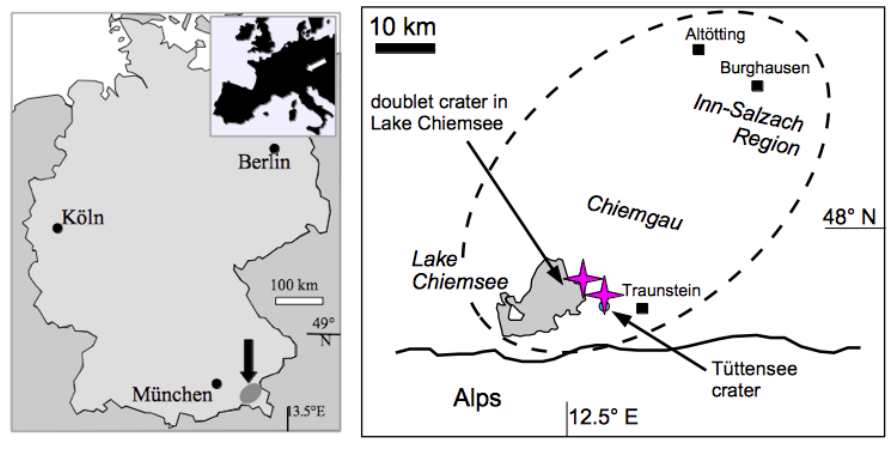 Fig. 1. Location map for the two pink quartz occurrences within the roughly elliptically encircled Chiemgau meteorite impact strewn field.
Fig. 1. Location map for the two pink quartz occurrences within the roughly elliptically encircled Chiemgau meteorite impact strewn field.
3 The pink quartz places of discovery
The pink quartz sands were discovered when soil and rock samples from interesting impact locations were systematically examined for potentially impact-related microparticles like glass, metallic and carbon spherules. Experienced observers could not overlook the concentration of so many pink quartz grains (Fig. 2), especially when they used a strong magnet to separate the magnetic fraction and found that the pink quartz grains could also be separated by an obviously slightly enhanced susceptibility of the basically paramagnetic quartz. The first sample was excavated near the village of Marwang north of the Lake Tüttensee crater (Fig. 1) during a campaign of recording magnetic susceptibility profiles of the upper 50 cm to map a known distinct peak of enhanced magnetic susceptibility (Fig. 3), which was first measured in the northern part of the impact strewn ellipse (Hoffmann et al. 2004). The Marwang magnetic peak is connected to a horizon enriched with fractured pebbles, cindery glass and carbonaceous spherules, which is considered to represent the original directly impact-affected Earth surface. Here, an accumulation of pink quartz grains attracted attention.
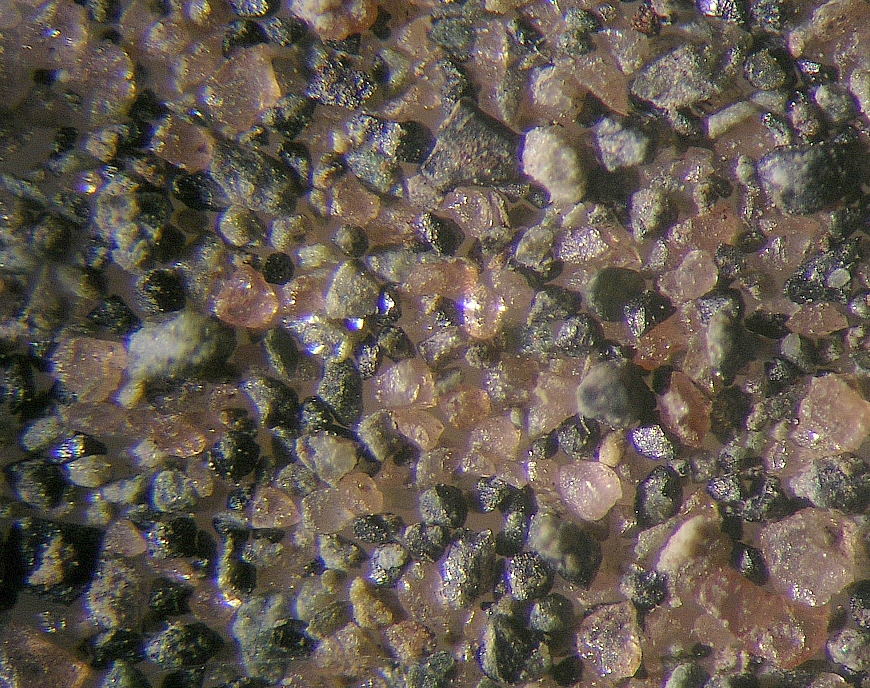
Fig. 2. Typical magnetic sand fraction with an enrichment of pink quartz grains. The dark fraction is mostly composed of ore and amphibolite. Field of view 4 mm.
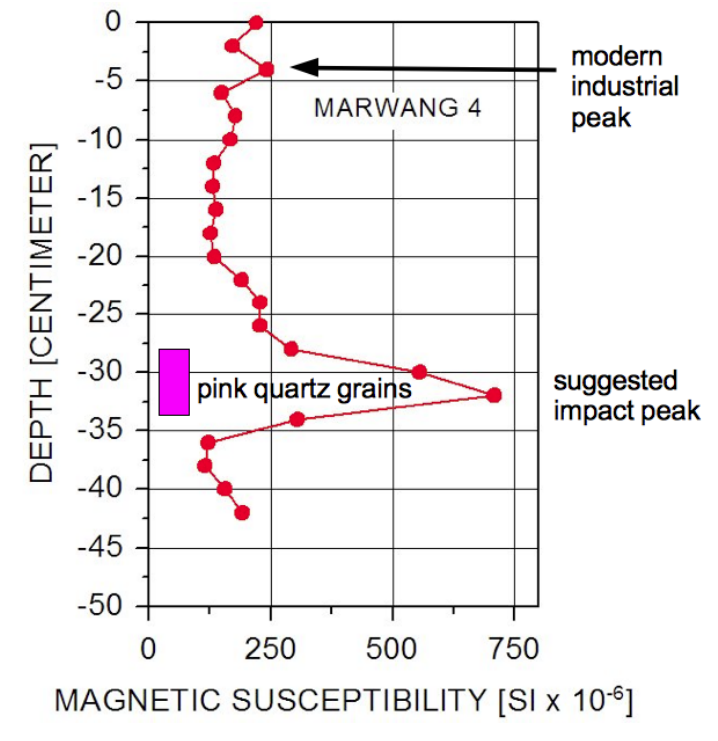
Fig. 3. Soil magnetic susceptibility profile with the suggested impact peak and sampling of the pink quartz grains.
The second sample comes from the diamictic layer found during the Stöttham archeological excavation a few hundred meters apart from the shoreline of Lake Chiemsee (Fig. 1). The several decimeters thick diamictite (Fig. 4) is embedded in colluvium layers and contains brecciated and heavily corroded clasts, abundant organic material like wood, charcoal, fractured animal bones and teeth, and intermixed archeological artifacts. High-temperature signature is characterized by partly melted silica limestone, a typical rock from the Alps, and sandstone clasts with sporadically interspersed glass. Moderate shock is indicated by an abundant and strong kink banding of micas in gneiss clasts from the diamictite, and most recently the author has established strong shock metamorphism in quartz in polymictic breccias from the horizon. Millimeter-sized glass and tiny carbonaceous spherules were extracted from the diamictite mud, the pink quartz grains being an important side effect. The outcrop has in detail been described in Ernstson et al. (2012), and there is no doubt about the connection with the Chiemgau impact event. The early description as a tsunami deposit (D. Sudhaus, pers. report) has meanwhile received full support (Ernstson 2016).
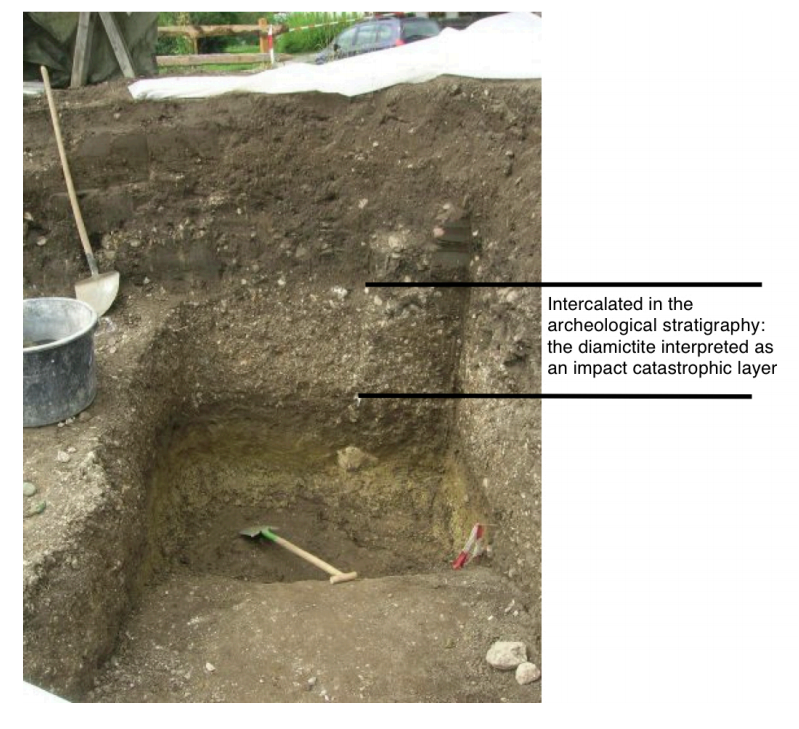
Fig. 4. The Stöttham impact catastrophic layer hosting pink quartz grains.
4 Formation hypothesis
The hypothesis of the formation of pink quartz in the Chiemgau impact strewn field is based on the original explanation of pink coloration by gamma irradiation in pegmatites, in which little quartz silicon was substituted by phosphorous and aluminum (see 1 Introduction). The following sequence of processes could have taken place in the Chiemgau impact event (Fig. 5): A huge plasma cloud in the airburst of the comet or asteroid approaches the Earth. – Fast neutrons from the plasma bombard the Earth’s surface and hit exposed water-bearing quartz sands. – The fast neutrons are captured by collision with hydrogen nuclei and lose most of their energy due to the same mass, to become slow or thermal neutrons. – The capture process is accompanied by the emission of a strong gamma radiation. – The gamma radiation hits mineralogically “well prepared” quartz grains to now obtain their pink color. – Immediate post-impact sedimentation by probably enormous precipitations prevents exposure to sunlight and discoloration. So much for a physical scenario of a possible formation of the pink quartz grains in the Chiemgau impact strewn field, the significance of which is discussed below.
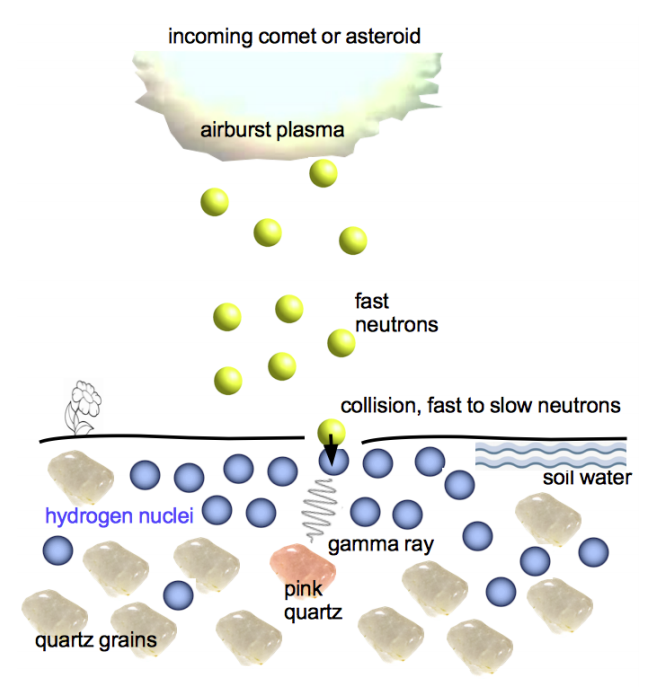
Fig. 5. Model of pink quartz formation in the Chiemgau meteorite impact event. See text.
5 Discussion and Conclusions
The following observations are fulfilled: In the Chiemgau impact crater strewn field quartz sands were excavated that contain a certain amount of pink quartz. The grains are as clear as rock crystal quartz. The pink grains are slightly enhanced paramagnetic, as they can be separated from normal grains with a strong magnet. This property has not yet been reported for other pink quartz. Originally surprising for the author, but now understood was the observation that the pink color disappeared after the grains were exposed to daylight for some time, which has also been reported for other pink quartz (see 1 Introduction).
A chemical analysis of the pink quartz grains by e.g. SEM EDS has not been done so far and will be performed when new samples are available. The general context with earlier discovered pink quartz (see above) is given, taking into account the delivery area for the quartz sands that are the nearby Alpine mountains where quartz pegmatites and phosphorous mineralization are common. Direct observations of pink quartz in the Alps are unknown, and in view of the herds of mineral collectors, the discovery of this rare variety would have been reported. On the other hand, it cannot be ruled out that other rare chemical elements that replace silicon may also be susceptible to irradiation pink coloring, which must be checked. This also applies to the slightly enhanced magnetic susceptibility of the Chiemgau pink quartz, and a superparamagnetic behavior cannot be excluded.
This reminds of an unusual observation in the Chiemgau impact strewn field, namely the occurrence of strongly magnetized Quaternary limestone cobbles and boulders from the Alps, which were excavated, for example, from the smaller Kaltenbach and Mauerkirchen impact craters showing much evidence of impact overprint (Neumair and Ernstson 2011, Procházka and Trojek 2017. Moreover, the limestones, which are normally magnetic sterile, have demonstrably acquired considerable ferrimagnetism and associated superparamagnetism (Neumair and Ernstson 2011, Procházka and Kletetschka 2016). As the limestone cobbles and boulders are completely untouched at the outside, shock magnetization is considered. It can currently be speculated whether superparamagnetism was shock-generated not only in the otherwise “nonmagnetic” limestones, but also in the pink quartz grains with a slightly different chemistry than “normal” quartz.
This does not affect the irradiation hypothesis for the pink coloring as related to an impact neutron bombardment of water-bearing quartz sands and a secondary gamma radiation (Fig. 5) postulated for the other pink quartz occurrences.
A heavy neutron bombardment during the Chiemgau impact event has been discussed by us earlier when several radiocarbon (14C) ages for deep-seated (2 – 3 m) organic matter (bones, wood) in impact catastrophe layers (Lake Tüttensee ejecta layer; Ernstson et al. 2010) gave far too high 14C values corresponding to impossible medieval and even today’s ages. Inconclusive radiocarbon ages are not unknown for dating of young impacts (e.g., Rasmussen et al. 2000). In our case an impact plasma neutron bombardment could have initiated what normally happens in the atmosphere to produce the more or less constant 14C level as the known basis for the radiocarbon dating. In the atmosphere, spallation neutrons collide with nitrogen 14N nuclei, which leads to a nuclear reaction and production of the radioactive 14C. Neutrons that bombard the Earth’s surface in an impact event could collide with 14N isotopes in organic matter, and the same reaction as in the atmosphere could occur, which produces excess 14C and today’s too young ages.
In conclusion: There is much evidence from earlier investigations in the Chiemgau impact strewn field that huge airbursts could have played a major role (Ernstson et al 2010, Rappenglück et al. 2017, Shumilova et al. 2018). Plasma formation has inevitably bombarded the earth’s surface with strong neutron showers. Fast neutron collisions with hydrogen nuclei from water-bearing quartz sands produced the gamma radiation for pink quartz coloring, which is considered to be the cause for the previously known sites of pink quartz.
The next steps in the investigation of the Chiemgau pink quartz will be reported in an article’s Part 2. A systematic search for more occurrences is planned and, with a positive result, a documentation of their distribution in relation to other impact features in the crater strewn field and possibly at places definitely outside the crater field. Pink quartz grain sizes will be measured, whereby a preferred sorting is checked. SEM EDS analyses for phosphorous, aluminum or other elements will be performed. A test of magnetic behavior and rock-magnetic properties, e.g. for superparamagnetism, are planned. A controlled observation of a possible discoloring in daylight may follow.
If these or other data are available, it may be possible to confirm or question the impact neutron-gamma radiation hypothesis, and a search for pink quartz in other impact structures may be promising.
References
Akhavan, A.C. http://www.quartzpage.de/pink.html © 2005-2013 (accessed July 31, 2018).
Balitsky, V.S., Makhina, I.B., Prygov, V.I., Mar’in, A.A., Emel’henko, A.G., Fritsch, E., McClure, S.F., Taijing, L., DeGhionno, D., Koivula, J.I., Shigley, J.E. (1998). Russian Synthetic Pink Quartz. Gems and Gemology: 34: 34-43.
Bauer, F., Hiltl, M., Rappenglück, M.A., Neumair, A., & Ernstson, K. (2013). Fe2Si (Hapkeite) from the subsoil in the alpine foreland (Southeast Germany): Is it associated with an impact? Meteoritics & Planetary Science, 48 (S1) (76th Annual Meeting of the Meteoritical Society), Abstract #5056.
Dake, H.C., Fleener, F.L., Wilson, B.H. (1938). Quartz Family Minerals: A Handbook for the Mineral Collector, 304 p., Whittlesey House, McGraw-Hill Book Company.
Ernstson, K. (2016). Evidence of a meteorite impact-induced tsunami in lake Chiemsee (Southeast Germany) strengthened. 47th Lunar and Planetary Science Conference, Abstract #1263.
Ernstson, K., Mayer, W., Neumair, A., Rappenglück, B., Rappenglück, M.A., Sudhaus, D., & Zeller, K. (2010). The Chiemgau crater strewn field: Evidence of a Holocene large impact event in Southeast Bavaria, Germany. Journal of Siberian Federal University Engineering & Technologies, 1/3, 72–103.
Ernstson, K., Mayer, W., Neumair, A., & Sudhaus, D. (2011). The sinkhole enigma in the Alpine Foreland, Southeast Germany: Evidence of impact-induced rock liquefaction processes. Central European Journal of Geosciences, 3/4, 385–397.
Ernstson, K., Sideris, C., Liritzis, I., & Neumair, A. (2012). The Chiemgau meteorite impact signature of the Stöttham archaeological site (Southeast Germany). Mediterranean Archaeology and Archaeometry, 12/2, 249–259.
Ernstson, K., Shumilova, T. G., Isaenko, S. I., Neumair, A., & Rappenglück, M. A. (2013). From biomass to glassy carbon and carbynes: Evidence of possible meteorite impact shock coalification and car- bonization. Modern problems of theoretical, experimental and applied mineralogy (Yushkin Memorial Seminar–2013): Proceedings of mineralogical seminar with international participation (S. 369–371). Syktyvkar: IG Komi SC UB RAS.
Ernstson, K., Hiltl, M., & Neumair, A. (2014). Microtektite-like glasses from the Northern Calcareous Alps (Southeast Germany): Evidence of a proximal impact ejecta origin. 45th Lunar and Planetary Science Conference, Abstract #1200.
Ernstson, K. & Neumair, A. (2011), Geoelectric Complex Resistivity Measurements of Soil Liquefaction Features in Quaternary Sediments of the Alpine Foreland, Germany, Abstract NS23A-1555 presented at 2011 Fall Meeting, AGU, San Francisco, Calif., 5-9 Dec.
Ernstson, K., & Poßekel, J. (2017). Meteorite impact „earthquake“ features (Rock liquefaction, surface wave deformations, seismites) from ground penetrating radar (GPR) and geoelectric complex resistivity/induced polarization (IP) measurements, Chiemgau (Alpine Foreland, Southeast Germany). Abstract (EP53B-1700) presented at 2017 Fall Meeting, AGU, New Orleans, LA.
Hiltl, M., Bauer, F., Ernstson, K., Mayer, W., Neumair, A., & Rappenglück, M.A. (2011). SEM and TEM analyses of minerals xifengite, gupeiite, Fe2Si (hapkeite?), titanium Carbide (TiC) and cubic moissanite (SiC) from the subsoil in the Alpine Foreland: Are they cosmochemical? 42nd Lunar and Planetary Science Conference, Abstract #1391.
Hoffmann, V., Rösler, W., and Schibler, I., (2004). Anomalous magnetic signature of top soils in Burghausen area, SE Germany. Geophysical Research Abstracts, 6: 05041.
Hoffmann, V., Tori, M., Funaki, M. (2006). Peculiar magnetic signature of FeSilicide phases and dia- mond/fullerene containing carbon spherules. Travaux Géophysiques XXVII – Abstracts of the 10th „Castle Meeting“ – New Trends in Geomagnetism, Paleo, Rock and Environmental Magnetism, 52–53.
Hori, H. (2001). Nomenclature of Quartz Color Variation: Pink and Rose. Mineralogical Record: 32(1).
Isaenko, S. I., Shumilova, T. G., Ernstson, K., Shevchuk, S., Neumair, A., & Rappenglück, M. (2012). Carbynes and DLC in naturally occurring carbon matter from the Alpine Foreland, South-East Germany: Evidence of a probable new impactite. European Mineralogical Conference, 1, EMC 2012–217.
Liritzis, I., Zacharias, N., Polymeris, G.S., Kitis, G., Ernstson, K., Sudhaus, D., Neumair, A., Mayer, W., Rappenglück, M.A., & Rappenglück, B. (2010). The Chiemgau meteorite impact and tsunami event (Southeast Germany): First osl dating. Mediterranean Archaeology and Archaeometry 10/4, 17–33.
Maschmeyer, G. Lehmann (1983). A trapped-hole center causing rose coloration of natural quartz. Zeitschrift für Kristallographie, 163, 181-196.
Neumair, A. & Ernstson, K. (2011), Geomagnetic and morphological signature of small crateriform structures in the Alpine Foreland, Southeast Germany, Abstract GP11A-1023 presented at 2011 Fall Meeting, AGU, San Francisco, Calif., 5-9 Dec.
Procházka, V., & Trojek, T. (2017). XRF- and EMP- investigation of glass coatings and melted domains of pebbles from craters in Chiemgau, Germany. 48th Lunar and Planetary Science Conference, Abstract #2401.
Procházka, V. & Kletetschk, G. (2016). Evidence for superaparamagnetic nanoparticles in limestones from Chiemgau crater field, SE Germany. 47th Lunar and Planetary Science Conference (2016); Abstract #2763.pdf.
Rappenglück, B., Rappenglück, M., Ernstson, K., Mayer, W., Neumair, A., Sudhaus, D., & Liritzis, I. (2010). The fall of Phaeton: a Greco-Roman geomyth preserves the memory of a meteorite impact in Bavaria (south-east Germany). Antiquity, 84, 428–439.
Rappenglück, M., Schüssler, U., Mayer, W., & Ernstson. K. (2005). Sind die Eisensilizide aus dem Impakt-Kraterstreufeld im Chiemgau kosmisch? European Journal of Mineralogy, 17(1), 108.
Rappenglück, M. A., Bauer, F., Hiltl, M, Neumair, A., & K. Ernstson, K. (2013). Calcium-aluminium-rich inclusions in iron silicide (xifengite, gupeiite, hapkeite) matter: Evidence of a cosmic origin. Meteoritics & Planetary Science, 48(S1), (76th Annual Meeting of the Meteoritical Society), Abstract #5055.
Rappenglück, M. A., Bauer, F., Ernstson, K., & Hiltl, M. (2014). Meteorite impact on a micrometer scale: Iron silicide, carbide and CAI minerals from the Chiemgau impact event (Germany). Proceedings of Problems and Perspectives of Modern Mineralogy (Yushkin Memorial Seminar – 2014), Syktyvkar, 106–107.
Rappenglück, M.A,., Rappenglück, B. & Ernstson. K. (2017). Kosmische Kollision in der Frühgeschichte. Der Chiemgau-Impakt: Die Erforschung eines bayerischen Meteoritenkrater-Streufelds. Zeitschrift für Anomalistik, 17, 235-260.
Rasmussen, K.L., AAby, B., Gwozdz, R. (2000). The age of the Kaalijärvi meteorite craters. Meteoritics & Planetary Science, 35, 1067-1071.
Rösler, W., Hoffmann, V., Raeymaekers, B., Schryvers, D., & Popp, J. (2005). Carbon spherules with diamonds in soils. Paneth Kolloquium, Abstract PC2005 #026.
Rykart, R. (1995). Quarz-Monographie – Die Eigenheiten von Bergkristall, Rauchquarz, Amethyst, Chalcedon, Achat, Opal und anderen Varietäten. 413 p., Ott, Thun.
Schryvers, D., & Raeymaekers, B. (2005). EM characterisation of a potential meteorite sample. Proceedings of EMC, Antwerp, vol. II, 859–860.
Schüssler, U., Rappenglück, M. A., Ernstson, K., Mayer, W., Rappenglück, B. (2005). Das Impakt-Kraterstreufeld im Chiemgau. European Journal of Mineralogy, 17(1), 124.
Shumilova, T.G., Isaenko, S.I., Makeev, B.A., Ernstson, K., Neumair, A., & Rappenglück, M.A. (2012). Enigmatic poorly structured carbon substances from the Alpine Foreland, Southeast Germany: Evidence of a cosmic relation. 43rd Lunar and Planetary Science Conference, Abstract & Poster #1430.
Shumilova, T.G., Isaenko, S.I, Ulyashev, V.V., Makeev, B.A., Rappenglück, M.A., Veligzhanin, A.A., & Ernstson, K. (2018). Enigmatic glass-like carbon from the Alpine 12 Foreland (Southeast Germany): Formation by a natural carbonization process. Acta Geologica Sinica – English Edition, in press.
Yang, Z. Q., Verbeeck, J., Schryvers, D., Tarcea, N., Popp, J., & Rösler, W. (2008). TEM and Raman characterisation of diamond micro- and nanostructures in carbon spherules from upper soils. Diamond & Related Materials, 17, 937–943.







































































